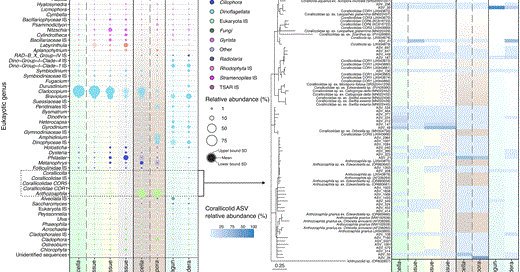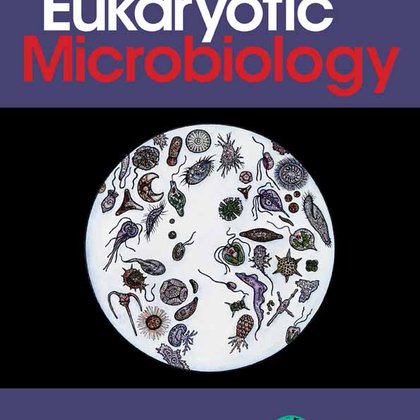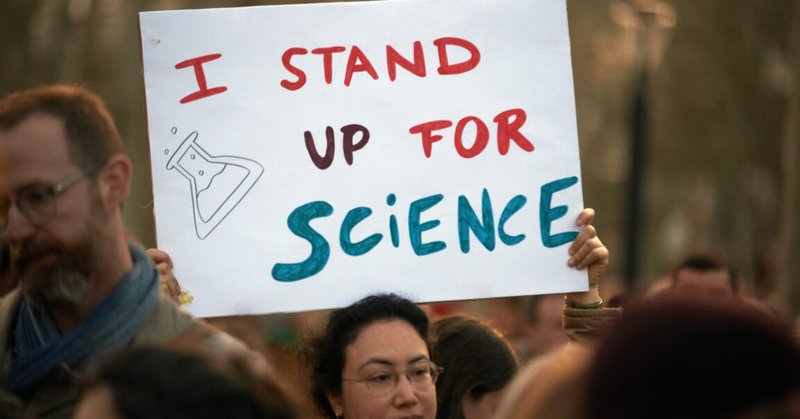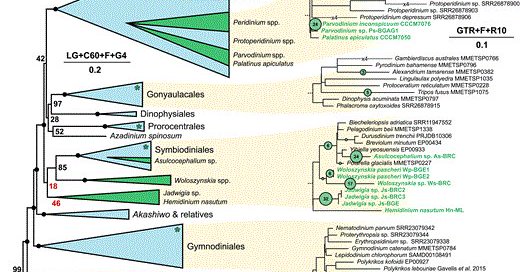
Anthony Bonacolta
@AMBonacolta
Followers
809
Following
9K
Media
207
Statuses
2K
Postdoctoral fellow in the Keeling Lab @ UBC studying marine protistan symbionts. Previously: del Campo Lab & Coral Reef Futures Lab 🌊🧬 He/Him 🏳️🌈
Miami, FL
Joined April 2018
🚨🧵Out now in @ISMEJournal! We find abundant corallicolid sequences within bearded fireworms across reefs and years in Curaçao 🇨🇼! 🪱🪸 This is the first report of corallicolids inside a non-anthozoan host! https://t.co/k55aK5IVKx
#Protists #Corals
academic.oup.com
Abstract. Corals (Cnidaria; Anthozoa) play critical roles as habitat-forming species with a wide range, from warm shallow-water tropical coral reefs to col
1
6
16
🙏 Thanks to all co-authors: Tatsuya Unuma, Joana Krause-Massaguer (@Joanakrause99), and Javier del Campo (@fonamental /@delCampoLab)!
0
3
6
Apostichocystis is named for its host (Apostichopus japonicus), while the species epithet gudetama draws from the Japanese pop icon Gudetama, a lazy egg, highlighting the parasite’s link to the ovaries. The name captures both ecological context and cultural ties to Japan 🇯🇵.
1
3
5
🌊 A. gudetama’s close relationship to these marine host–associated clades has interesting implications for apicoplast evolution, which we hope to explore further in the future ☀️
1
3
5
🧬 rrn operon phylogeny revealed this parasite to be closely related to apicomplexans of marine fish 🐟 and corals 🪸, while organelle phylogenetics hint at a closer relationship with Eleutheroschizon, an apicomplexan associated with a marine Polychaete 🪱
1
3
4
🆕 Out now in JEM (@JEukMicro)! Using gene and organelle phylogenies from recovered cysts, we describe Apostichocystis gudetama, an apicomplexan parasite found in the ovaries of the Japanese sea cucumber 🥚🥒🇯🇵
onlinelibrary.wiley.com
Unknown ellipsoid bodies, later classified as apicomplexan cysts, are prevalent in the ovaries of Japanese sea cucumbers (Apostichopus japonicus), where they can lead to lower fecundity in infected...
1
6
10
This work was co-led by me and @BradWeilerDives under the guidance of @fonamental. Huge thanks to our amazing collaborators: Candace Grimes, Morelia Trznadel, Mark Vermeij, & Patrick Keeling! 🙏
0
2
4
🌟 Taken together, we suggest fireworms are a reservoir and potential vector for corallicolids, moving parasites between coral hosts via feces 🪱💩🪸. This deepens our understanding of coral reef host-parasite interactions and reveals exciting new corallicolid ecology!
1
2
4
🧪 To dig deeper, we teamed up with Dr. Candace Grimes, who amplified 16S rRNA genes in fireworms across body compartments back in 2017. With this data we confirmed a high corallicolid apicoplast presence in the gut and feces of worms 🪱💩.
1
2
4
🔎 We found corallicolids were abundant in all sampled worms — and distinct from the ones in the corals the worms fed on!
1
1
1
🔥 This exciting discovery started with an interesting observation: corallivourous fireworms feeding along the disease line of a black band diseased Orbicella annularis colony! The @delCampoLab team spotted this while investigating coral diseases in partnership with CARMABI🧪🏝️
1
3
6
We are glad to announce that #MidweekMicrobe is back! Today we are celebrating the International Children's Book Day coinciding with Hans Christian Andersen's birthday. A creative mind, Hans published the tale The Drop of Water in 1847, available at https://t.co/83buHWybPa.
1
3
5
The ways he has to validate their emotions and explain correlation and causation with the patience of a kindergarten teacher
"I just had a baby... I was like no, I'm not gonna get any vaccines. The doctors came in. They made me feel like a very bad mother." Doctor Mike takes on 20 anti-vaxxers in our latest episode of Surrounded
537
21K
323K
The far-right has always targeted and will always target science and scientists, as they target public workers, unions, or minorities. #standupforscience, yes, but stand up for everyone that suffers the actions of the far-right in the US and elsewhere. ✊🧪 https://t.co/4qiwBErhf4
arstechnica.com
Schools across the country are cutting back as US research takes “severe blow.”…
0
2
7
Fireworms (Hermodice carunculata) are a reservoir and potential vector for coral-infecting apicomplexans https://t.co/zCJT2Opken
#biorxiv_micrbio
biorxiv.org
Corals (Cnidaria; Anthozoa) play critical roles as habitat-forming species with a wide range, from warm shallow-water tropical coral reefs to cold-water ecosystems [[1][1]–[3][2]]. They also repres...
0
5
6
Going into the severe weather and hurricane season, this cannot be good. The Commerce Department has laid off hundreds of NOAA employees, many with specialized skills who work at one of the world's top climate science and weather forecasting agencies. Why it matters: The
2K
6K
20K
Probationary employees across @NOAA and the @NWS are being terminated today, including those in mission-essential roles. My own wife is among them, essential to the Pacific Tsunami Warning Center's 24/7 critical mission of seismic monitoring and tsunami prediction to protect the
I never publicly comment on political matters because they are usually irrelevant to my work of providing hurricane data and forecasts to people in my personal capacity. Today though, it is highly relevant, and as a member of the meteorological community, I am angry. Planned or
502
2K
5K
Phylogenomic resolution of marine to freshwater dinoflagellate transitions
academic.oup.com
Abstract. Dinoflagellates are an abundant and diverse group of protists that inhabit aquatic environments worldwide. They are characterized by numerous uni
0
2
17
Happy to be part of this study led by Patrick Keeling's lab 😀 Phylogenomics of coral-infecting corallicolids reveal multiple independent losses of chlorophyll biosynthesis in apicomplexan parasites #corals #symbiosis
https://t.co/V8b73at6mf
0
6
33














